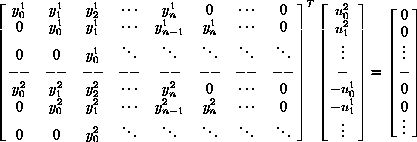- A very simple application of the polynomial Chinese remainder theorem:
- Show that the solution to M(z)X(z)=1 mod(z-a) is X(z)=1/M(a), provided M(a) isn't 0.
This is useful for the polynomial Chinese remainder theorem solution procedure. - Show you can formulate the interpolation problem X(zi)=ci as: X(z)=ci mod(z-zi), i=1...n.
- Apply the Chinese remainder theorem to derive the Lagrange interpolation formula.
y0+y1z+y2z²= (h0+h1z+h2z²) (u0+u1z+u2z²) mod(z³ -8).
HINTS: (1) z3-8=(z-2)(z² +2z+4); (2) z² +2z+4=(z-2)(z+4)+12.
You can use the latter hint to avoid the Euclidian algorithm for polynomials, if desired.
- We wish to multiply (3458)(2992) using residue number systems (illustrative example).
- Compute the residues of 3458 and 2992 for each modulus (total of 16 numbers).
- Compute the residues of the product for each modulus (total of 8 numbers).
- Use the Chinese remainder theorem to compute (3458)(2992). Confirm this is right.
Use as moduli: 2,3,5,7,11,13,17,19; their product is about 10 million (large enough).
We observe yn=hn*un={143,96,199,97,217,199,274,156,146,114,78,83,34,11,1}.
GOAL: To reconstruct BOTH hn and un from their convolution yn (2 unknowns).
All we know is hn and un are scaled to positive integers, 0 < h,u < 10, n > 0.
Compute hn and un. HINT: Use the Euclidian algorithm repeatedly, and 143=(13)(11).
We observe yn¹=hn*un¹={1,13,78,286,715,1287,1716,1716,1287,715,286,78,13,1}
and observe yn²=hn*un²={1,7,23,49,80,112,144,176,199,185,121,47,8}.
GOAL: Compute hn,un¹,un² from yn¹,yn².
These sequences need NOT be integer-valued; we know NOTHING except that WLOG h0=1.
- Compute hn, un¹ and un² in three ways (which one is easiest?):
- By finding the common zeros of Y¹(z) and Y²(z), and using them to compute H(z).
Don't be surprised if this doesn't work well; how do you identify exactly common zeros? - By applying the Euclidian algorithm for polynomials to Y¹(z) and Y²(z).
- By writing Y¹(z)U²(z)-Y²(z)U¹(z)=0 as the linear system of equations
